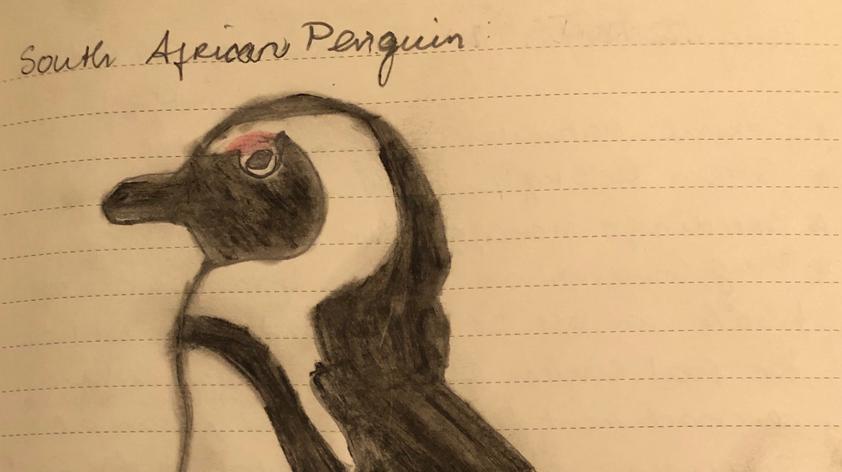
It’s not all about that one sperm! Extra-pair copulation in the South African penguin
The Jackass penguin. A funny name, I thought as I sketched out one of our cute little South African penguins. As a scientist, I like to doodle when faced with a difficult task. It helps me to focus my thoughts and organize my next steps.
Did you know that the donkey-like bray of their mating call earned this cute 2-foot-tall South African penguin its nickname? Our flock of South African penguins can be seen in the big, new Dan and Vi McKinney Penguin Habitat at Cape Fynbos in the San Diego Zoo's Conrad Prebys Africa Rocks. As one of the most endangered penguins, it is our goal to learn more about these beautiful creatures, so we can slow their ever-faster decline.
A major challenge conservationists face when breeding a limited endangered population is the lack of genetic diversity. An important question on every breeders’ mind is how to increase the numbers of a small group without introducing the health shortcomings of inbreeding.
As a member of the Association of Zoos and Aquariums (AZA), the Population Management Center helps our bird department to manage our flock with a Species Survival Plan. With the aid of a studbook, containing the pedigree of every bird in the program, they advise zoos on the ideal pairings. Oftentimes, this leads to match-making of a genetically valuable penguin with a mate in another location. By doing this, the international zoo community ensures the genetically diverse and healthy survival of endangered species.
As you can imagine, it is very important that we know the pedigree of every penguin and their offspring. This is accomplished by our Bird Department’s expert management and care of the flock on-site. Even though pairings are closely monitored, each bird can’t be watched all of the time and some extra-matings can be missed. “But aren’t South African penguins monogamous?” you may ask.
This is true, but recent studies have shown that given the opportunity, some birds do stray from their mate. If it is assumed that the sire of a particular chick is automatically the male mated to the chick’s dam, there may be a problem with the studbook integrity.
To identify if extra-pair matings occur in the Zoo’s flock, we have proposed a novel egg testing approach.
As with the management of all captive populations, the flock’s demographics are closely monitored and controlled. Not every fertilized egg can advance to hatch due to resource constraints and the requirements of a continually growing colony.
Instead, birds are only allowed to incubate the eggs that provide chicks that offer the greatest genetic diversity. This means that most of the fertilized eggs are not incubated, giving us opportunistic access for our study. Only one sperm cell actually fertilizes the egg, while hundreds to thousands of other sperm get stuck in the egg membrane, thus holding the secret to the mating genetics.
We are developing a novel method to isolate and analyze the sperm DNA, so we can determine the identity of the male donors. We will use techniques similar to those used in Crime Scene Investigations, to generate a DNA fingerprint of the sperm donor(s). The genetic fingerprint can then be compared to all the males in the flock to pinpoint the exact mate.
Our first major challenge is to extract enough sperm DNA from the fertilized egg to run the tests. This is no small feat, as there may be only hundreds of sperm on an individual egg, and these are degraded by enzymes fairly quickly after the egg is laid.
Once we have sufficient quantities of high-quality DNA, we can begin running experiments to identify the DNA fingerprint of the recovered sperm. Birds are very interesting creatures, and one of their unique traits is their ability to store sperm from multiple donors. This means that we may find DNA from multiple donors on a single egg. Our aim is to determine if and how often extra-pair mating is occurring in the Zoo’s flock and if it interferes with the pedigree in the studbook.
We invite you to follow us through our investigation. Our first step is to create a best practice approach to extract very small amounts of DNA from fertilized South African penguin eggs.













